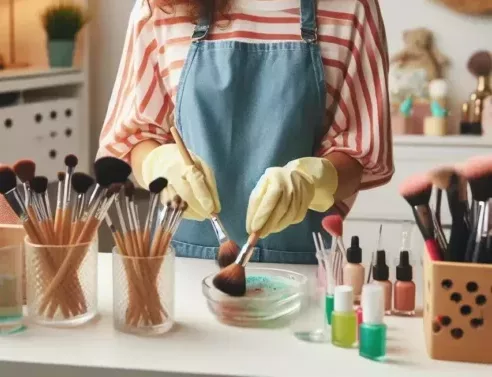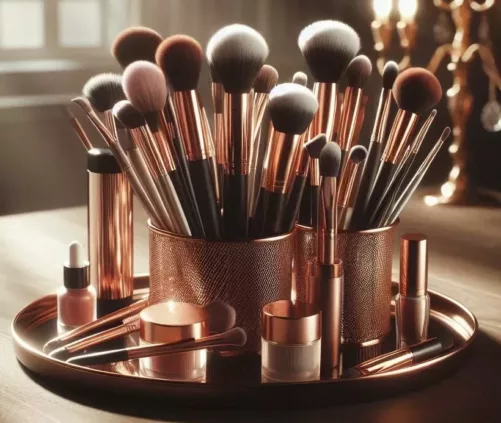Keeping your makeup brushes clean isn’t just for show. It’s a big deal for both your skin and your wallet. Dirty brushes can pile on bacteria, causing breakouts or irritation. Learning how to clean makeup brushes can save you cash in the long run.
Cleaning makeup brushes isn’t complex, but there are steps you definitely want to follow for the best results. First, you need to gather your cleaning materials. We’re talking about a good cleansing agent and a water source. Next, wet your brush bristles with warm water — but remember, no drowning the brush. You’ll want to keep the handle dry to avoid weakening the glue. Apply a dab of cleaner onto your hand or a brush cleaning mat, lather gently, then rinse thoroughly. It’s a rinse and repeat game until the water runs clear.
Once cleaning is done, gently squeeze out the excess water and reshape the bristles. Lay the brushes flat on a clean towel to dry. Standing them upright can cause water to seep into the handle, loosening the glue over time. Let them air dry completely before moving them back into your kit.
To get started, you’ll need a few essentials. Grab some soap or cleanser specifically designed for brushes. If you’re in a pinch, baby shampoo can work too. A gentle hand soap could do the trick, but some folks even swear by dish soap like Dawn for its powerful grease-cutting properties. A brush cleaning mat might help with stubborn products caked in the bristles, making the job quicker and more effective.
Best Practices for Brush Cleaning: Industry Insights
The right way to clean your brushes can make all the difference. For most brushes, gentle is the name of the game. A mild soap combined with lukewarm water cleans well without breaking the bank. It’s a bit like laundering delicate clothes: you want them clean but you don’t want them to look worn out after a single wash.
Most professional makeup artists will tell you that technique is key. They often use specialized cleansers to maintain the integrity of the bristles, applying gentle pressure in a swirl pattern on their palm or on a textured brush mat. This helps lift makeup and dirt from every corner of the brush without fraying or damaging the precious bristles.
Dish soaps like Dawn have gained popularity for cutting through layers of makeup stuck on brushes, especially synthetic ones. But remember, it’s strong stuff. Make sure to rinse thoroughly so nothing harsh gets left behind on the bristles. If in doubt, a brush-specific cleanser is always a safe choice.
Debates around using things like micellar water often pop up. It’s okay for a quick cleanse, especially on smaller or eye brushes, but it doesn’t replace a deep clean. Think of micellar water as a once-in-a-while refresher, not your go-to for routine cleans.
Consistency is crucial. Whether you’re washing brushes daily like pros during fashion shows or weekly for personal use, keeping on schedule keeps bacteria and buildup at bay. A quick clean takes just a few minutes, and if you aim for a thorough wash every week, your skin and brushes will thank you.
Avoid These Common Mistakes When Cleaning Brushes
Keeping your brushes clean is important, but it’s just as crucial to avoid common slip-ups that might seem harmless but affect your brushes or your skin. One big no-no is using extremely hot water. Sure, it might feel like you’re zapping germs away, but you’re more likely to damage the brush fibers and loosen the glue holding them together.
Another mistake to dodge is soaking the entire brush. Dunking your brush underwater in the name of cleanliness can cause water to seep into the handle, leading to wood expansion or even mold. Trust me, it’s not worth the dry-rot smell. Instead, focus on just the bristles and keep the handle out of the splash zone.
Using the wrong soap can be another pitfall. Harsh detergents may seem efficient, but they can strip natural oils from your brushes, making them brittle over time. Gentler alternatives are best for maintaining softness and preventing fray.
Over-zealous scrubbing is a fast track to misshapen, worn-out brushes. It’s tempting to press harder thinking it will clean better, but gentle swirls get the job done without damaging the bristles.
Finally, stand brushes upright to dry, and you’re inviting water to dribble down to the glue holding those fibers together. Lay them flat instead or tilt them with the bristles hanging over the edge of a counter to let them air dry naturally. This way, brushes stay intact and are ready to perform when you are.
How Professional Makeup Artist Clean Their Brushes
Professional makeup artists usually follow a two-step system. A Quick-clean between clients using alcohol-based brush cleansers or sprays for rapid disinfection and drying. A deep-clean regularly (often nightly) with gentle soaps or specialty brush shampoos and warm water. Many pros also use color-removing sponges and UV sterilizers for added hygiene. Are you asking what is a color-removing sponge? A tool used to quickly remove powder pigment from makeup brushes without water or chemicals, allowing for immediate color switching. These roughly textured sponges are designed to be used dry, making them convenient for makeup artists and anyone who wants to switch between colors quickly while doing their makeup. They know that clean tools not only protect skin but also help achieve flawless results.
Choosing Effective Cleansers for Optimal Brush Care

When it comes to picking the right cleanser for your brushes, it’s all about balance. You want something strong enough to remove stubborn makeup but gentle enough to keep bristles soft and intact.
Many swear by dish soap, particularly Dawn, for its grease-cutting power. It’s especially effective if you use cream-based or oil-heavy products. Just remember, thorough rinsing is key to ensure no residue is left behind.
Dedicated brush cleaners have their perks too. They’re formulated specifically for this task, striking a balance between cleaning power and care for delicate bristles. These are often enriched with conditioning agents that help maintain brush softness and shape.
If bacterial buildup is a concern, soaps with antibacterial properties can do wonders. These help ensure that your brushes aren’t just visibly clean but also hygienic. Still, whatever soap you choose, rinsing well is crucial because leftover soap can cause skin irritation.
Experiment with a few different types of cleansers to find what works best. Sometimes, a mix of a gentle baby shampoo and a squirt of dish soap gets that perfect clean without harshness. Make sure the soap is gentle and free of harsh sulfates or fragrances, especially for natural-hair brushes. For more information on makeup brushes and applicators, please check out Makeup Applicator Tools 101: Brushes, Fingers, or Sponges? Here’s How to Choose.
Final Thoughts
Cleaning your makeup brushes doesn’t have to be a chore—just a part of your regular self-care ritual. Aim to clean foundation and concealer brushes once a week, and eye brushes every 1–2 weeks, depending on usage. Your skin (and your makeup game) will thank you! In the end, the best soap for your brushes is one that effectively cleansing without compromising on care. Keep it gentle, keep it thorough, and those brushes will stay fresh and ready for another masterpiece.

